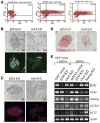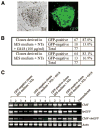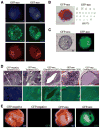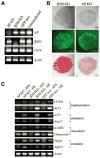Nucleofection mediates high-efficiency stable gene knockdown and transgene expression in human embryonic stem cells
- PMID: 18323409
- PMCID: PMC3882114
- DOI: 10.1634/stemcells.2007-0857
Nucleofection mediates high-efficiency stable gene knockdown and transgene expression in human embryonic stem cells
Abstract
High-efficiency genetic modification of human embryonic stem (hES) cells would enable manipulation of gene activity, routine gene targeting, and development of new human disease models and treatments. Chemical transfection, nucleofection, and electroporation of hES cells result in low transfection efficiencies. Viral transduction is efficient but has significant drawbacks. Here we describe techniques to transiently and stably express transgenes in hES cells with high efficiency using a widely available vector system. The technique combines nucleofection of single hES cells with improved methods to select hES cells at clonal density. As validation, we reduced Oct4 and Nanog expression using siRNAs and shRNA vectors in hES cells. Furthermore, we derived many hES cell clones with either stably reduced alkaline phosphatase activity or stably overexpressed green fluorescent protein. These clones retained stem cell characteristics (normal karyotype, stem cell marker expression, self-renewal, and pluripotency). These studies will accelerate efforts to interrogate gene function and define the parameters that control growth and differentiation of hES cells. Disclosure of potential conflicts of interest is found at the end of this article.
Conflict of interest statement
The authors indicate no potential conflicts of interest.
Figures





References
-
- Pera MF, Reubinoff B, Trounson A. Human embryonic stem cells. J Cell Sci. 2000;113:5–10. - PubMed
-
- Jones JM, Thomson JA. Human embryonic stem cell technology. Semin Reprod Med. 2000;18:219–223. - PubMed
-
- Donovan PJ, Gearhart J. The end of the beginning for pluripotent stem cells. Nature. 2001;414:92–97. - PubMed
-
- Lerou PH, Daley GQ. Therapeutic potential of embryonic stem cells. Blood Rev. 2005;19:321–331. - PubMed
-
- Kobayashi N, Rivas-Carrillo JD, Soto-Gutierrez A, et al. Gene delivery to embryonic stem cells. Birth Defects Res C Embryo Today. 2005;75:10–18. - PubMed
Publication types
MeSH terms
Substances
Grants and funding
LinkOut - more resources
Full Text Sources
Other Literature Sources
Research Materials

